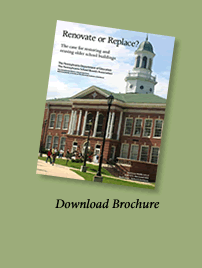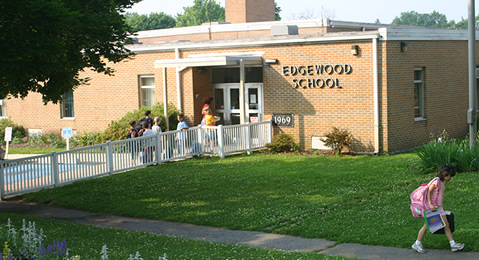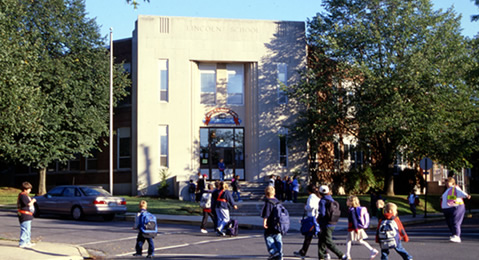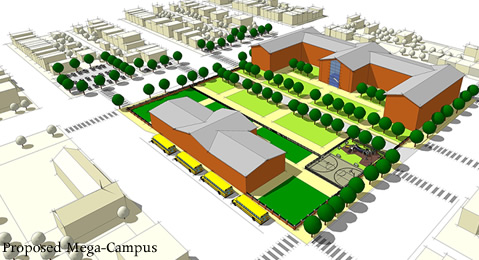 |
||||||||||||||||||
 |
||||||||||||||||||
|
Pottstown School District Abstract: For more than a decade, the Pottstown School District, located 35 miles northwest of Philadelphia, debated whether to renovate, replace or consolidate its five neighborhood elementary schools. In 2006, the school board decided to close all five schools and replace them with a consolidated school campus for about 1,700 students in grades K through 5. More than 100 homes in a two-square block area of Pottstown’s national register historic district would be acquired and demolished to make room for the consolidated campus. The five elementary schools would then be sold to the private sector and demolished for new housing. In 2007, a slate of five challengers defeated five incumbents on a pledge to retain and renovate the five elementary schools. After the election, the school district architect conducted a feasibility study funded by Save Our Land Save Our Towns Inc. which demonstrated that the cost of renovating the five existing schools was at least $13 million less than the cost of a new consolidated school campus, not including the cost of land acquisition and development. The Pottstown School District is contiguous with the borough of Pottstown (population 21,000), an old industrial borough located along the Schuylkill River 35 miles northwest of Philadelphia. The school district has a centrally located high school and middle school campus to which all students can walk. It has five elementary schools spread along the outer fringe of borough, with enrollments ranging from 250 to 450 pupils. In 1997, the district hired to an architect to conduct a feasibility study of the district’s schools which concluded they all needed to be renovated or replaced. Subsequently, the high school and middle school were renovated and enlarged during a three year period ending in 2001 at a cost of more than $40 million. The school district commissioned a second feasibility study by a different architect for the elementary schools in 2001. The district hired a third architect in 2003 to review and recommend changes to the second feasibility study. In December 2003, five new members were elected to the school board, and the following year the school board president proposed building a new pre-school center in downtown Pottstown for four- and five-year-old kindergarten students. With the initial cooperation of the Pottstown School District, the Pottstown Planning Commission engaged an educational facilities planner, David Anstrand, to conduct a study of various options for renovating Pottstown’s elementary schools and housing Pottstown’s pre-school students. Later, the district withdrew its support for the study, which was published as a supplement to the Pottstown Mercury in February 2005. To read the study, click here. The following year, the plan to build a pre-school center ballooned into a proposal to close all five schools and replace them with a mega-campus costing $52 million. The scheme called for acquiring and demolishing more than 100 homes and other buildings in a two-square block area in Pottstown’s national register historic district and replace them with a three-building campus housing elementary school students in grades K-1, 2-3, and 4-5. The land was to be acquired with state grants totaling about $20 million. The district would pay the $40 million-plus cost of the three school buildings: Pottstown Mercury Board moves closer to mega-campus choice By Evan Brandt Insisting that the newly acquired focus does not represent a final decision of the board, school board President Barry Robertson nevertheless concluded a lengthy debate on the issue by stating, "It is my opinion that if we do anything other than full consolidation (of the elementary schools onto one campus) we will break the back of this community." The motion on which the vote was taken -- which solicitor Stephen Kalis said is "not a resolution" -- reads in part: "Resolved that the school board begin preparations through our architects and business office toward establishing a central campus in the Washington Street neighborhood, which will include three centers (K-1, 2-3 and 4-5) and further, "Resolved that we authorize our solicitor to begin the process to arrange for any necessary legal steps to bring this to fruition." "We’re not making a decision, we’re simply focusing on one option," said board Vice President James Smock, who heads the district’s half of the Washington corridor and which asked for and drafted the prepared motion. "It sure sounds like a decision when you say it that way," said school board member Judyth Zahora, who, with Robert Hartman, voted against the motion. "That says to me that this is what the board has decided to do," Zahora said. "As a school board member, I’m not ready to make that commitment." Zahora raised a number of objections to the motion, and the option it represents, including the potential for the plan to eliminate neighborhood playgrounds at the elementary schools. She also pointed out that the Jan. 19, 2006, resolution adopted by the board says, "The construction of an early educational facility will not commence until the redevelopment is completed." Kalis pointed out that the resolution was amended seven months later to read that the district would proceed, "so long as all necessary funding and redevelopment commitments to proceed with the overall redevelopment effort are secured and the construction of an early educational facility will not commence until the redevelopment plan is complete." Responsibility for completion of that plan lies with Pottstown Borough officials and there has been little movement on this issue on the borough’s end. The amended resolution also requires that "the school board determines the campus is secure for its students." That would not change, vowed board member Philip Thees. Hartman argued that when the Superintendent’s Commission on Redistricting finished its work, the understanding with which it ended was that the district would reduce the number of elementary schools from five to three, but that they would still be K-5 schools. "We have evolved to where we’re at today. How many more ideas can we keep coming up with?" asked board member Edwin Edwards, who, for the first time in a public meeting, began to display outward signs of impatience. "We wait and we wait, and we have meetings and we go to meetings and it all gets tiresome," said Edwards, who has a background in construction and is slated to head the school board’s construction committee when the time comes for development. Hartman shifted his objections to the potential cost of having the lawyers and architects begin work. "I look at this and I see dollar sign, dollar sign," he said. Superintendent David Krem said it was necessary for architects to get an exact measurement of the space, adding, "We don’t even know if it will fit." He later explained that statement was an exaggeration. Hartman responded angrily to this, saying, "You mean you sent us to all those meetings with people screaming at us and you didn’t even know if it would fit? Why bother?" The report issued two weeks ago by Econsult addressed that issue and suggests that the consolidation plan, called the "mega-campus" by some of its detractors, holds the greatest potential for shoring up Pottstown’s tax base, Robertson said. Some of those detractors are running for the school board on the platform of opposing the "mega-campus" plan. Although three of them were in the audience Thursday night, none spoke publicly about the debate or the motion. In the end, the two most important things to consider, Robertson said, are the borough’s tax base and the quality of education being provided by the school system. "No matter what we do, we’re never going to make everybody happy," said school board member Bonita Barnhill. "We have to do what provides the most good for the greatest number of people," said school board member Cathy Skitko. Because the consolidation option provides the most positive impact on both matters, it remains Robertson’s top choice. "Frankly, at this point, I think the second best option is to do nothing at all," said Robertson. "This is dead serious business, folks. In many ways, this may be our last best chance."
Even as the school board voted to proceed with plan for the mega-campus, a slate of five candidates calling themselves the “Neighborhood Schools Team” challenged five incumbents with a pledge to renovate the district’s five elementary schools. The challengers, who cross-filed for the May 2007 primary election, won on both ballots by a five-to-one to one margin, thus ensuring their election in November 2007. To read an account of the election in the Pottstown Mercury, click here. After the primary election, Tom Hylton, on behalf of Save Our Land, Save Our Towns Inc., received the school board’s permission to engage the school district’s architect at Save Our Land’s cost to conduct a case study looking at five options for the elementary schools, assuming enough capacity for 1,850 pupils:
Figures based on actual proposed floor plans of the renovated schools were provided by Crabtree Rohrbaugh and Associates, the district’s architect. Additional figures and floor plans for some options were provided by another architect the district has used in the past, McKissick Associates. The study found that renovating the existing five elementary schools was the least expensive option. Constructing the consolidated campus would cost $50.6 million, not including land acquisition and site preparation costs. Renovating five schools would cost $37 million. Closing two schools and renovating and enlarging the remaining three would cost $42.7 million. For the complete breakdown, click here. As of August 2008, the Pottstown School Board has not yet decided on a course of action, except to eliminate the mega-campus option.
|
|||||||||||||||||||||||||||||||||||||||||||||||||||||||||||||||||||||||||||||||||||||||||||||||||||



